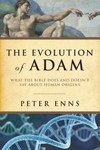In my last post, we looked at some options for how to bring Adam and evolution into conversation. Today, we begin to look at the factors that have to be addressed when building a “model.”
 A model is a way of “putting the pieces” together that accounts for as many pieces of the puzzle in as compelling a way as possible. So, when discussing Adam today, a pretty big “piece” is evolution. Talking about Adam in a way that ignores this “piece” will not be compelling.
A model is a way of “putting the pieces” together that accounts for as many pieces of the puzzle in as compelling a way as possible. So, when discussing Adam today, a pretty big “piece” is evolution. Talking about Adam in a way that ignores this “piece” will not be compelling.
The same holds for ancient Near Eastern literature. Any talk of Adam that does not account for the similarities and differences between Israel’s origins stories and those of Israel’s neighbors won’t be compelling.
We don’t have all the pieces, however. Think of it as 100o piece puzzle where only, say, 300 are in the box. Skilled puzzle solvers dump the pieces and begin separating out the edge pieces, and they find that most of the boarder can be put together.
Then they group together similar pieces–those that look like grass and trees, others of sky and clouds, etc. Many of those pieces fit together nicely and are placed inside the frame where the puzzlers’ skill and experience tell them they should go: grass and trees down here, sky and clouds up there.
What the puzzle as a whole looks like is a matter of working with the pieces you have, putting them where they most reasonably belong, and filling in the empty spaces based on your general knowledge of what puzzles look like, and that more sky is likely to be up there, more grass and trees down there, an animal of some sort over here (because one piece has a tell-tale paw on one edge).
OK., I’m killing this analogy. You get the idea.
That is what biblical scholars do. We put pieces together and fill in the gaps as best as we can. Any attempt to solve the puzzle that leaves pieces in the box or puts sky where grass should be will not be compelling.
A good model of Adam will account for the pieces and make a case for where those pieces belong and how they hang together. So, what are the pieces of the puzzle that have to be accounted for? That is what the next slide begins to address.
 Adam is mentioned in Genesis and in Paul’s letters (Romans 5 and 1 Corinthians 15). For each of these authors–living in different times and places–we need to be mindful of three factors.
Adam is mentioned in Genesis and in Paul’s letters (Romans 5 and 1 Corinthians 15). For each of these authors–living in different times and places–we need to be mindful of three factors.
(1) Near literary context. One must account for the words the text before us, i.e., how it behaves, what it is “saying” on its own terms. This is often refered to as “grammatical-historical” interpretation. So, what do Genesis and Paul actually say about Adam?
(2) Canonical context. What Genesis says about Adam must be placed in the larger context of what the Old Testament says as a whole, and what Paul says about Adam must be placed in the larger context of what the New Testament says about Adam.
(3) Cultural context. Neither Genesis nor Paul’s letters is written in a vacuum, but in cultures where origins was widely discussed. What these biblical authors say about Adam must be placed against the backdrop of the cultural moment(s) in which they were doing their writing.
One caution is that these factors are not mutually exclusive–they interact with each other, which is sort of the point for why we have to look at all three (hence, the connecting blue lines).
Only after we do the work of thinking through Genesis and Paul in terms of these three interweaving contexts can we bring Genesis and Paul into a meaningful biblical theological conversation and begin answering the question: “What is Adam doing in the Bible?”
Then–and only then–can one turn to the issue of how evolution and Adam can be in conversation.
In my opinion, many of the problems with the Adam/evolution discussion stem from short-circuiting this process. For example, taking the near literary context of Genesis, comparing it to evolution, and saying, “Well, that doesn’t fit.”
Looking at Genesis and Paul in their larger canonical and cultural contexts helps us understand what the biblical authors were saying and why–which helps us understand what we might have the right to expect from the story of Adam.
But that is no quick fix; it is a process that takes some patience. Welcome to the world of biblical interpretation.
OK, I spent too much time talking about puzzle pieces and such. In my next post, I’ll outline some of the details a bit more (unless I think of another analogy and get wordy again).










